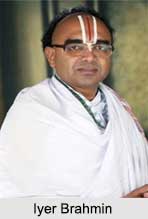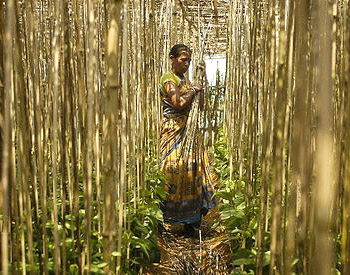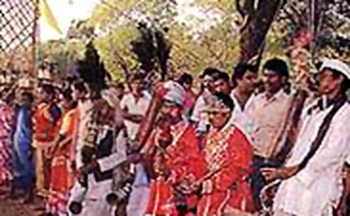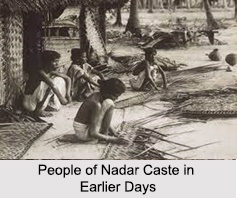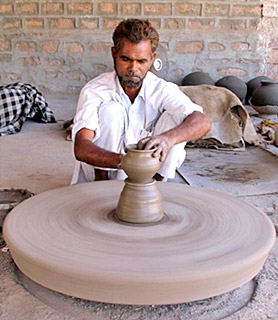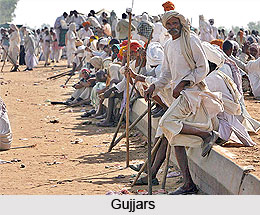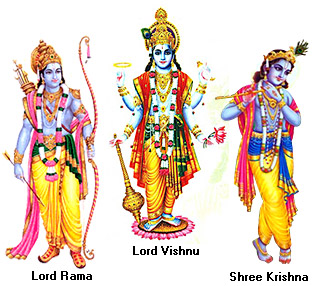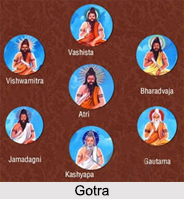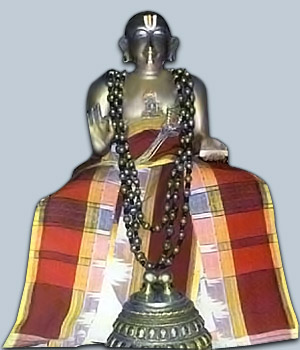 Development of Vaishnavism in post Vedanta Desika period extended over six centuries and was popularly known as Sri Vaishnavism. It developed along two parallel schismatic lines. One sect owed its allegiance to Vedanta Desika and the other to Manavalamamuni. The Vadakalai sect, which followed Vedanta Desika, has had a long line of succession of eminent acharyas. Two important mathams or religious centres came into existence initially, one known as Ahobila Matham and the other as Parakala Matham. Both were headed by eminent ascetics (Sanyasis) for the propagation of the Ramanuja Siddhanta as interpreted by Vedanta Desika. Subsequently in the 18th century, another centre known as Andavan Asramam came into existence headed by ascetics. The important acharyas who have contributed scholarly works are: Kumara Vedantacharya (1316-1401), son of Vedanta Desika, Brahmatantra Parakala Swami I (1286-1386), first pontiff of Parakala Matham and some of his successors (who were the pontiffs of Parakala Matham) Adivan Sathakopayati (A.D. 1398), first pontiff of Ahobila Matham and some of his successors, Mahacharya (1509-91), Tatacharya (16th century), Rari garamanujamuni (16th century), Srinivacharya (17th century), Narsimharaja (17/18th century), Paravastu Vedantacharya (18th century), Tatadesika (18th century), Vedantaramanuja Swami (also known as Saksat Swami), Gopaladesika (18th century) and many others. The books written in Sanskrit are mostly in the form of commentaries or glossaries on the works of Ramanuja and Vedanta Desika. Some are devoted to a criticism of Advaita doctrines; some are intended to uphold the Supremacy of Lord Vishnu as against the criticism of Saivites, some are devoted to the explanation of the Sri Vaishnavas. Some of these acharyas, particularly Rarigaramanuja Muni, Vedantaramanuja and Periya Parakala Swami (21st pontiff of Parakala Matham) have written commentaries on the Tamil hymns of the Alvars.
Development of Vaishnavism in post Vedanta Desika period extended over six centuries and was popularly known as Sri Vaishnavism. It developed along two parallel schismatic lines. One sect owed its allegiance to Vedanta Desika and the other to Manavalamamuni. The Vadakalai sect, which followed Vedanta Desika, has had a long line of succession of eminent acharyas. Two important mathams or religious centres came into existence initially, one known as Ahobila Matham and the other as Parakala Matham. Both were headed by eminent ascetics (Sanyasis) for the propagation of the Ramanuja Siddhanta as interpreted by Vedanta Desika. Subsequently in the 18th century, another centre known as Andavan Asramam came into existence headed by ascetics. The important acharyas who have contributed scholarly works are: Kumara Vedantacharya (1316-1401), son of Vedanta Desika, Brahmatantra Parakala Swami I (1286-1386), first pontiff of Parakala Matham and some of his successors (who were the pontiffs of Parakala Matham) Adivan Sathakopayati (A.D. 1398), first pontiff of Ahobila Matham and some of his successors, Mahacharya (1509-91), Tatacharya (16th century), Rari garamanujamuni (16th century), Srinivacharya (17th century), Narsimharaja (17/18th century), Paravastu Vedantacharya (18th century), Tatadesika (18th century), Vedantaramanuja Swami (also known as Saksat Swami), Gopaladesika (18th century) and many others. The books written in Sanskrit are mostly in the form of commentaries or glossaries on the works of Ramanuja and Vedanta Desika. Some are devoted to a criticism of Advaita doctrines; some are intended to uphold the Supremacy of Lord Vishnu as against the criticism of Saivites, some are devoted to the explanation of the Sri Vaishnavas. Some of these acharyas, particularly Rarigaramanuja Muni, Vedantaramanuja and Periya Parakala Swami (21st pontiff of Parakala Matham) have written commentaries on the Tamil hymns of the Alvars.
The other school of thought headed by Manavalamamuni has carried on the propagation of Sri Vaishnavism through a line of successive Tenkalai acharyas. Manavalamamuni also known as Varavaramuni was born in A.D. 1370 and lived up to A.D. 1443. He has commented extensively on the important Manipravaja works of Pillai lokacharya. He also wrote commentaries on the works of other acharyas, one on the hymns of Periyalvar and three independent works in Tamil such as Upadesa rattinamalai, Tiruvaymoli nutranaddi and Artiprapandam. His only work in Sanskrit language is Yatiraja vimsati, laudatory twenty verses on Ramanuja. He had a line of successors who spread his teachings all over the country. Their works are mostly in Manipravaja language and are devoted to an exposition of the esoteric doctrines of Sri Vaishnavism and the hymns of the Alvars. The followers of Manavalamamuni have generally given greater importance to the teachings of the Alvars.
As in the School of Vadakalai, the Tenkalai School of thought too had set up mathams or religious centres headed by on ascetic (sanyasi) to propagate Vaishnavism. The chief mathams of Tenkalai School are Vanamamalai Matham at Nanguneri near Tirunelveli in South India (whose pontiff is called Vanamamalai Jiyar), Tirumalai Jiyar Matham at Tirupati, one at Srirangam known as Sriranganarayana Jiyar Matham and Yatiraja Matham at Melkote (Karnataka). All these mathams have served for centuries as important religious centres for the study of Vaishnava philosophy and propagation of Vaishnava religion.










